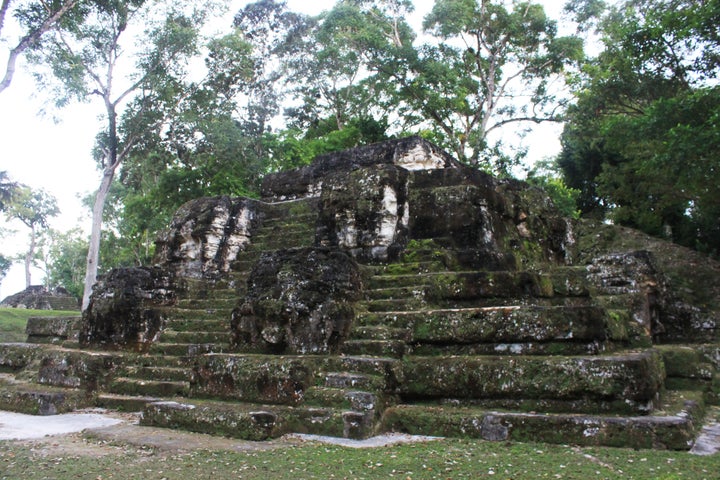
Religious iconography is as thick on the colectivo creaking down the lime white path through the jungle as the smell of sweat and hair grease. The chrome ceiling claims the risen Lord is a perpetual passenger and seven rosaries bounce along with 14 aging breasts as the bus jolts over roots and rocks. The young man hanging out the door to high five the foliage wears a shirt that superimposes wings on his shoulder blades, and a girl I take to be his sister is listening to praise music of some stripe on her pristine, pink walkman.
Given the ethereal transport, it seems only logical that Uaxactun -- pronounced like D.C. but with a lazy tongue -- should emerge from the forest as a heavenly vision. It has the good grace to do precisely that.
On the evening I arrive, the airstrip that serves as both the town green and the part between the two hairy hills on which the town's hundred or so homes perch, is full of boys playing soccer and girls chasing baby birds. The town's poverty is both instantly obvious and fleetingly appealing when illuminated by the soft glow of a forest fringed sun. The light plays so fetchingly off the leathered wrinkles and sinewy muscle of the men drinking homebrew shirtless on a bench that it is easy to forget that their bulk is hard won and that they're younger than they appear.
Though I told the manager of Aldana's, where I would stay in a tool shed glorified by a wooden cot and lit by a candle purchased separately, that I had come to see the ruins as we conversed on the bus, I was certainly lying. I had decided to come here despite the inconvenience to see the town itself, which may be the closest modern approximation to a Maya city: Commoners' thatched-roof homes still sit in the shadow of temples here very much as John Smith Maya's home used to sit beneath the great temples of Tikal, now given over day-trippers.
As I emerge from the bus, a toddler holding a tin cup nods towards me in exactly the way one might expect a penguin to nod to a ostrich, accepting at once my existence and its complete irrelevance. This is not a tourist town. In fact, I find the ruins, a ring of two story temples, hard to find for a lack of signage. I visit them because they're there and scamper back towards town as the thick air begins to turn grey and misty.
I'm struck by the fact the town's 963 citizens -- the number is freshly scrawled on a sign -- don't look particularly Maya. They're phenotypically Guatemalan: Only a few hook noses and high foreheads are on display though their shortness does indicate their history.
As evening rolls toward night, the lights go out and an explosion sends children scampering home toward their smoky backyards. Freelance mutts take to the streets, their bat's wing ears fluttering then pausing to determine whether motors belong to bikes or generators.
Uaxactun owes its existence to the chicle boom of the 1940s, when the Wrigleys of the world descended on this part of Guatemala in search of the rubbery sap oozing from trees deep in the forest. The airstrip at the heart of town was used to fly out the harvests of the Chicleros, some of whom still wander the forest for months at a time tapping trees.
The Chicleros and their children know this forest well because it has been theirs for countless generations. The Maya biosphere, which is so impossible to penetrate that rumors of massive illegal logging camps and black market towns circulate, is very lightly dusted with settlements and governed extralegally by its Maya inhabitants. The automatic rifle-toting officers that line the roads north from the Belize border crossing past placid Lake Peten are nowhere to be found this far into the forest.
But the anarchy here is of the summer evening variety. Children toss embers with flat boards and adolescents hot dog on souped-down motorbikes. Nothing terribly sinister seems to be afoot as the Milky Way begins to emerge from the dark blue sky. In towns as small as this, the law becomes a matter of your mother's friend's neighbor's judgment.
I wander toward the general store, which is operated by a woman who handles a flashlight with the proficiency of a Broadway lighting tech, and buy a bottle of water. A pair of young boys on bikes sneak up behind me and suddenly ring their bells, making me jump.
"Hola," they yell as they adios around a corner.
If the Maya once confused white conquistadors for Gods, they seem unlikely to make the mistake again. In fact, there is a sort of defensive solipsism that seems to have taken hold of the town. Inside the barn-like Catholic church, the altar is decorated with colorful, unrecognizable idols. The tiny local restaurant has a sign asking customers to call the owner if they'd like a meal. No number is given.
The intimacy of the town is relatable, but it is also proof of the Maya culture's permanent change. The boundless ambition on display at the ruined cities all over Central America, cities connected by massive infrastructure, is completely unmatched in Uaxactan. Vodka bottles litter the archeological preserve's plaza, which sits a few hundred yards into the forest beyond the chicken-wired edge of the town proper. The young warrior etched into a stella discovered here -- his headdress paying tribute to his own people's gods -- bears little resemblance to the boys watching television through the window of nearby bar.
Perched at the edge of the wild, these modern Maya have become anything but. Still, after disease, war and recent political unrest, their equanimity may be a blessing all its own.
